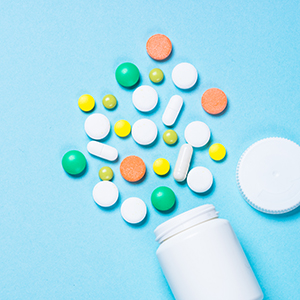Endo-App Lernmodul
Vitamine, Mineralien, Spurenelemente – Nahrungsergänzungsmittel und Endometriose
Worum geht es?
Sind Nahrungsergänzungsmittel bei Endometriose oder überhaupt sinnvoll?
Modul-Autor:in

Silke Neumann ist Ernährungsberaterin BfD e.V. und schreibt nach vielen Jahren in Praxis und Klinik nun als freie Autorin zu ernährungsmedizinischen Themen.
Wissenschaftliche Grundlagen des Moduls
Scientific Opinion on Dietary Reference Values for folate (2014). In: EFS2 12 (11), S. 55.
Abokhrais, Ibtisam M.; Denison, Fiona C.; Whitaker, Lucy H. R.; Saunders, Philippa T. K.; Doust, Ann; Williams, Linda J.; Horne, Andrew W. (2020): A two-arm parallel double-blind randomised controlled pilot trial of the efficacy of Omega-3 polyunsaturated fatty acids for the treatment of women with endometriosis-associated pain (PurFECT1). In: PloS one 15 (1), e0227695. DOI: 10.1371/journal.pone.0227695.
Bruner-Tran, Kaylon L.; Osteen, Kevin G.; Taylor, Hugh S.; Sokalska, Anna; Haines, Kaitlin; Duleba, Antoni J. (2011): Resveratrol inhibits development of experimental endometriosis in vivo and reduces endometrial stromal cell invasiveness in vitro. In: Biology of reproduction 84 (1), S. 106–112. DOI: 10.1095/biolreprod.110.086744.
Bundesinstitut für Risikobewertung (BfR) (2021): Fragen und Antworten zu Nahrungsergänzungsmitteln.
Carrington‐Smith, Denise (2005): Mawson and Mertz: a re‐evaluation of their ill‐fated mapping journey during the 1911–1914 Australasian Antarctic Expedition. In: Medical Journal of Australia 183 (11-12), S. 638–641. DOI: 10.5694/j.1326-5377.2005.tb00064.x.
Chambial, Shailja; Dwivedi, Shailendra; Shukla, Kamla Kant; John, Placheril J.; Sharma, Praveen (2013): Vitamin C in Disease Prevention and Cure: An Overview. In: Indian Journal of Clinical Biochemistry 28 (4), S. 314–328. DOI: 10.1007/s12291-013-0375-3.
Charoenngam, Nipith; Holick, Michael F. (2020): Immunologic Effects of Vitamin D on Human Health and Disease. In: Nutrients 12 (7). DOI: 10.3390/nu12072097.
Deutsche Gesellschaft für Ernährung: Folat. Online verfügbar unter https://www.dge.de/nachrichten/detail/referenzwerte-fuer-die-zufuhr-von-folat-aktualisiert/#:~:text=Jugendlichen%20und%20Erwachsenen%20empfiehlt%20die,450%20%C2%B5g%20Folat%20pro%20Tag.
Deutsche Gesellschaft für Ernährung (DGE): Gemüse- und Obstprodukte als Nahrungsergänzungsmittel.
EU – European Parliament: Consolidated text: Regulation (EC) No 1924/2006 of the european parliament and of the council of 20 December 2006 on nutrition and health claims made on foods. Online verfügbar unter https://eur-lex.europa.eu/legal-content/EN/TXT/?uri=CELEX%3A02006R1924-20141213.
Halpern, Gabriela; Schor, Eduardo; Kopelman, Alexander (2015): Nutritional aspects related to endometriosis. In: Revista da Associacao Medica Brasileira (1992) 61 (6), S. 519–523. DOI: 10.1590/1806-9282.61.06.519.
Hannibal, Luciana; Lysne, Vegard; Bjørke-Monsen, Anne-Lise; Behringer, Sidney; Grünert, Sarah C.; Spiekerkoetter, Ute et al. (2016): Biomarkers and Algorithms for the Diagnosis of Vitamin B12 Deficiency. In: Frontiers in Molecular Biosciences 3. DOI: 10.3389/fmolb.2016.00027.
Harris, H. R.; Eke, A. C.; Chavarro, J. E.; Missmer, S. A. (2018): Fruit and vegetable consumption and risk of endometriosis. In: Human Reproduction (Oxford, England) 33 (4), S. 715–727. DOI: 10.1093/humrep/dey014.
Harris, Holly R.; Chavarro, Jorge E.; Malspeis, Susan; Willett, Walter C.; Missmer, Stacey A. (2013): Dairy-Food, Calcium, Magnesium, and Vitamin D Intake and Endometriosis: A Prospective Cohort Study. In: American Journal of Epidemiology 177 (5), S. 420–430. DOI: 10.1093/aje/kws247.
Kalaitzopoulos, Dimitrios Rafail; Lempesis, Ioannis G.; Athanasaki, Florentia; Schizas, Dimitrios; Samartzis, Eleftherios Pierre; Kolibianakis, Efstratios M.; Goulis, Dimitrios G. (2020): Association between vitamin D and endometriosis: a systematic review. In: Hormones (Athens, Greece) 19 (2), S. 109–121. DOI: 10.1007/s42000-019-00166-w.
Missmer, Stacey A.; Chavarro, Jorge E.; Malspeis, Susan; Bertone-Johnson, Elizabeth R.; Hornstein, Mark D.; Spiegelman, Donna et al. (2010): A prospective study of dietary fat consumption and endometriosis risk. In: Human Reproduction (Oxford, England) 25 (6), S. 1528–1535. DOI: 10.1093/humrep/deq044.
Mumford, Sunni L.; Weck, Jennifer; Kannan, Kurunthachalam; Buck Louis, Germaine M. (2017): Urinary Phytoestrogen Concentrations Are Not Associated with Incident Endometriosis in Premenopausal Women. In: The Journal of nutrition 147 (2), S. 227–234. DOI: 10.3945/jn.116.238840.
Na, Hyo-Seok; Ryu, Jung-Hee; Do, Sang-Hwan (2011): Magnesium in the Central Nervous System. The role of magnesium in pain. Hg. v. Robert Vink und Mihai Nechifor. Adelaide (AU).
Nielsen, Forrest H. (2018): Magnesium deficiency and increased inflammation: current perspectives. In: Journal of inflammation research 11, S. 25–34. DOI: 10.2147/JIR.S136742.
Oberweis, Didier; Madelenat, Patrick; Nisolle, Michelle; Demanet, Etienne (2016): A pilot double-blind, randomized, placebo-controlled trial of the efficacy of trace elements in the treatment of endometriosis-related pain: study design and methodology. In: NDS, S. 1. DOI: 10.2147/NDS.S92503.
Ozcan Cenksoy, Pinar; Oktem, Mesut; Erdem, Ozlem; Karakaya, Cengiz; Cenksoy, Cahit; Erdem, Ahmet et al. (2015): A potential novel treatment strategy: inhibition of angiogenesis and inflammation by resveratrol for regression of endometriosis in an experimental rat model. In: Gynecological endocrinology : the official journal of the International Society of Gynecological Endocrinology 31 (3), S. 219–224. DOI: 10.3109/09513590.2014.976197.
Pattanittum, Porjai; Kunyanone, Naowarat; Brown, Julie; Sangkomkamhang, Ussanee S.; Barnes, Joanne; Seyfoddin, Vahid; Marjoribanks, Jane (2016): Dietary supplements for dysmenorrhoea. In: The Cochrane database of systematic reviews 3, CD002124. DOI: 10.1002/14651858.CD002124.pub2.
Rutkowski, Maciej; Grzegorczyk, Krzysztof (2012): Adverse effects of antioxidative vitamins. In: International journal of occupational medicine and environmental health 25 (2), S. 105–121. DOI: 10.2478/S13382-012-0022-x.
Santanam, Nalini; Kavtaradze, Nino; Murphy, Ana; Dominguez, Celia; Parthasarathy, Sampath (2012): Antioxidant Supplementation Reduces Endometriosis Related Pelvic Pain in Humans. In: Translational research : the journal of laboratory and clinical medicine 161 (3), S. 189–195. DOI: 10.1016/j.trsl.2012.05.001.
Stiftung Warentest: Vitamine – viele Präparate sind zu hoch dosiert. Online verfügbar unter https://www.test.de/Vitamine-Viele-Praeparate-sind-deutlich-zu-hoch-dosiert-5220730-5220736/.
Taylor, Robert N.; Kane, Maureen A.; Sidell, Neil (2015): Pathogenesis of Endometriosis: Roles of Retinoids and Inflammatory Pathways. In: Seminars in reproductive medicine 33 (4), S. 246–256. DOI: 10.1055/s-0035-1554920.
Verbraucherzentrale: zu Nahrungsergänzungsmitteln. Online verfügbar unter https://www.verbraucherzentrale.nrw/wissen/lebensmittel/nahrungsergaenzungsmittel, zuletzt geprüft 2021.
Vitale, Salvatore Giovanni; Capriglione, Stella; Peterlunger, Isabel; La Rosa, Valentina Lucia; Vitagliano, Amerigo; Noventa, Marco et al. (2018): The Role of Oxidative Stress and Membrane Transport Systems during Endometriosis: A Fresh Look at a Busy Corner. In: Oxidative Medicine and Cellular Longevity 2018. DOI: 10.1155/2018/7924021.
Zarei, Somayeh; Mohammad-Alizadeh-Charandabi, Sakineh; Mirghafourvand, Mojgan; Javadzadeh, Yousef; Effati-Daryani, Fatemeh (2017): Effects of Calcium-Vitamin D and Calcium-Alone on Pain
Intensity and Menstrual Blood Loss in Women with Primary Dysmenorrhea: A Randomized Controlled Trial. In: Pain medicine (Malden, Mass.) 18 (1), S. 3–13. DOI: 10.1093/pm/pnw121.
Zemel, Michael B.; Sun, Xiaocun (2008): Dietary calcium and dairy products modulate oxidative and inflammatory stress in mice and humans. In: The Journal of nutrition 138 (6), S. 1047–1052. DOI: 10.1093/jn/138.6.1047.
Bundesinstitut für Risikobewertung (BfR) – https://www.bfr.bund.de/de/gesundheitliche_bewertung_von_nahrungsergaenzungsmitteln-945.html
Dr. Birgit Niemann, „Risiken einer Supplementation von Vitaminen und Mineralstoffen“, https://www.bfr.bund.de/cm/343/risiken-einer-supplementation-von-vitaminen-und-mineralstoffen.pdf
Dr. Birgit Niemann, „Risiken einer Supplementation von Vitaminen und Mineralstoffen“, Bundesinstitut für Risikobewertung, https://www.bfr.bund.de/cm/343/risiken-einer-supplementation-von-vitaminen-und-mineralstoffen.pdf
Pana, T.A., Dehghani, M., Baradaran, H.R. et al. Calcium intake, calcium supplementation and cardiovascular disease and mortality in the British population: EPIC-norfolk prospective cohort study and meta-analysis. Eur J Epidemiol (2020).
Deutsche Gesellschaft für Ernährung – Referenzwerte Vitamin C – https://www.dge.de/wissenschaft/referenzwerte/vitamin-c/?L=0
Deutsche Gesellschaft für Ernährung – Ausgewählte Fragen zu Vitamin C – https://www.dge.de/wissenschaft/weitere-publikationen/faqs/vitamin-c/#c1482
Fachgesellschaft für Ernährungstherapie und Prävention – Lebensmittel mit Vitamin B12 – https://fet-ev.eu/vitamin-b12/2/
Bundesinstitut für Risikobewertung – Stellungnahme – https://www.bfr.bund.de/cm/343/zinksalze-in-mundwasser-und-zahnpasta.pdf
Deutsche Gesellschaft für Ernährung – Zink https://www.dge.de/wissenschaft/referenzwerte/zink/?L=0
Trujillo E, Davis C, Milner J. Nutrigenomics, proteomics, metabolomics, and the practice of dietetics. J Am Diet Assoc. 2006; 106:403-13.
Deutsche Gesellschaft für Ernährung (DGE) https://www.dge.de/wissenschaft/weitere-publikationen/faqs/selen/?L=0#c1513
Deutsche Gesellschaft für Ernährung (DGE) https://www.dge.de/wissenschaft/weitere-publikationen/faqs/selen/?L=0#c1513
Bundesinstitut für Risikobewertung: Müssen Fischverzehrer ihre Ernährung durch Fischöl-Kapseln ergänzen? Information Nr. 034/2006 des BfR vom 19. Juli 2006 – https://www.bfr.bund.de/cm/343/muessen_fischverzehrer_ihre_ernaehrung_durch_fischoel_kapseln_ergaenzen.pdf
Tsuchiya M, Miura T, Hanaoka T, Iwasaki M, Sasaki H, Tanaka T, et al. Effect of soy isoflavones on endometriosis: interaction with estrogen receptor 2 gene polymorphism. Epidemiology. 2007 May;18(3):402–8.
Takaoka O, Mori T, Ito F, Okimura H, Kataoka H, Tanaka Y, et al. Daidzein-rich isoflavone aglycones inhibit cell growth and inflammation in endometriosis. J Steroid Biochem Mol Biol. 2018 Jul;181:125–32.
EFSA (Europäische Behörde für Lebensmittelsicherheit) – https://eur-lex.europa.eu/legal-content/EN/TXT/?uri=CELEX:02006R1924-20141213
Modulinhalte:
- Tag 1: Was sind Nahrungsergänzungsmittel und wozu sind sie nützlich?
- Tag 2: Magnesium
- Tag 3: Calcium
- Tag 4: ACE – Vitamine bei Endometriose
- Tag 5: Vitamin C – Antioxidantien
- Tag 6: Vitamin B12
- Tag 7: Vitamin D
- Tag 8: Folsäure
- Tag 9: Zink
- Tag 10: Selen – und Wiederholung
- Tag 11: Omega 3 Fettsäuren – Fischölkapseln
- Tag 12: Phytoöstrogene
- Tag 13: Resveratrol
- Tag 14: Zusammenfassung
- Tag 15: Zusammenfassung der natürlichen Nährstoffquellen



